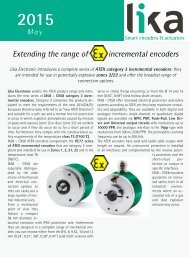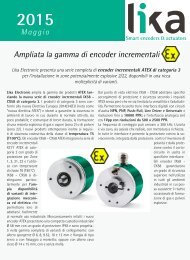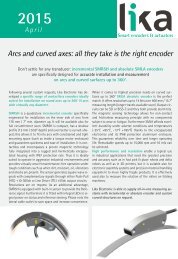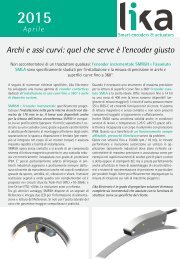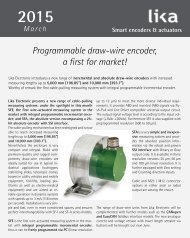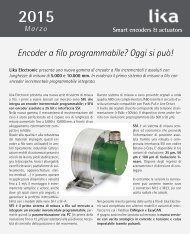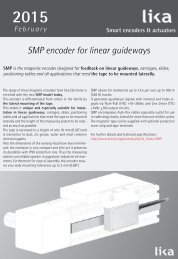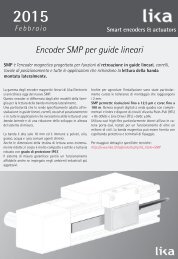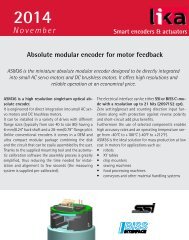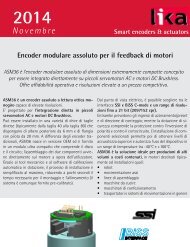LINEPULS & LINECOD catalogue 2016 in English
Lika Electronic incremental and absolute linear encoders catalogue 2016 in English Our new linear encoders catalogue is out now, and features many innovative new products and up-to-date information. The catalogue is expressly designed to set out the comprehensive range of incremental & absolute linear encoders from Lika Electronic. Check it out, it is completely renewed! Make sure you don’t miss out on a copy, download the pdf file from our web site or request your hard copy now! We have also got an interactive digital version in the works that shall be released soon!
Lika Electronic incremental and absolute linear encoders catalogue 2016 in English
Our new linear encoders catalogue is out now, and features many innovative new products and up-to-date information. The catalogue is expressly designed to set out the comprehensive range of incremental & absolute linear encoders from Lika Electronic. Check it out, it is completely renewed!
Make sure you don’t miss out on a copy, download the pdf file from our web site or request your hard copy now!
We have also got an interactive digital version in the works that shall be released soon!
Create successful ePaper yourself
Turn your PDF publications into a flip-book with our unique Google optimized e-Paper software.
<strong>LINECOD</strong><br />
Output codes<br />
The absolute encoders provide the absolute position <strong>in</strong>formation <strong>in</strong> a code format.<br />
The output <strong>in</strong>formation can be represented <strong>in</strong> B<strong>in</strong>ary or Gray code.<br />
In the base-2 number system only two digits are used: 0 and 1.<br />
For this reason it is the base of data process<strong>in</strong>g <strong>in</strong> comput<strong>in</strong>g and electronic systems where<br />
0 and 1 can be represented, electronically, as states “off” and “on”.<br />
B<strong>in</strong>ary code represents the <strong>in</strong>formation through the base-2 number system.<br />
It is very efficient, but has a great disadvantage from the po<strong>in</strong>t of view of the measur<strong>in</strong>g<br />
equipment: more than one digit at a time often changes <strong>in</strong> consecutive positions.<br />
Because of the variations caused by gate delays, l<strong>in</strong>e impedances, etc. transitions do not<br />
occur simultaneously and this could result <strong>in</strong> erroneous read<strong>in</strong>gs and therefore lead to significant<br />
measur<strong>in</strong>g errors.<br />
Consider, for <strong>in</strong>stance, the follow<strong>in</strong>g sequence:<br />
B<strong>in</strong>ary code<br />
Decimal 0 1 2 3 4 5 6 7<br />
B<strong>in</strong>ary<br />
(4 digits)<br />
0000 0001 0010 0011 0100 0101 0110 0111<br />
Gray<br />
(4 digits)<br />
0000 0001 0011 0010 0110 0111 0101 0100<br />
From position 1 to 2 (decimal), the last two digits both change <strong>in</strong> the b<strong>in</strong>ary representation<br />
(0 → 1; 1 → 0). The same happens from position 3 to 4, where the last three digits all<br />
change (0 → 1; 1 → 0; 1 → 0). Dur<strong>in</strong>g operation, a sens<strong>in</strong>g error of the detection elements<br />
could result <strong>in</strong> a position<strong>in</strong>g command error. For <strong>in</strong>stance, let’s suppose the follow<strong>in</strong>g wrong<br />
sequence: 0001 → 0011 → 0010 (position 1 → 3 → 2 <strong>in</strong>stead of 1 → 2 → 3).<br />
Motion controller would command position 1, then position 3 and then a reverse motion to<br />
position 2. Anyway please consider that Lika encoders are designed to always ensure that<br />
only consecutive position values are transmitted.<br />
B<strong>in</strong>ary code 4-bit representation (high logic level is represented <strong>in</strong> black)<br />
As B<strong>in</strong>ary code, also Gray code, patented by Bell Laboratories researcher Frank Gray <strong>in</strong> 1947,<br />
represents the <strong>in</strong>formation through the base-2 number system; but the b<strong>in</strong>ary str<strong>in</strong>gs are<br />
ordered so that two successive values differ <strong>in</strong> only one bit at a time (see the table under the<br />
“B<strong>in</strong>ary code” po<strong>in</strong>t). This is a safer method than B<strong>in</strong>ary code, because any sequence where<br />
more than one bit changes at a time can be easily and immediately detected by the control<br />
unit. Anyway, the maximum error is always the LSB value.<br />
Gray code<br />
Gray code 4-bit representation (high logic level is represented <strong>in</strong> black)<br />
35




